Spotify Playlist Promotion for Beginners

You might have heard that, in order to have a chance on hitting a deal with a record label, your Spotify artist profile needs to look appealing, especially when it comes to your number of streams and followers. Even if you're not trying to get signed, you're probably wanting to see an increase in your Spotify numbers as an independent artist.
Are you considering Spotify Music Promotion to up your game? Before you jump in, check out this comprehensive guide that should answer all of your questions about how it works.
Remember, Spotify Playlists are just one marketing tool in your toolkit, but when used properly, you can have results.
Spotify Playlists are the single most cost-effective way to generate traffic toward your music on Spotify. There are now tons of playlist placement companies that exist for giving independent artists access to these playlists. However, the music industry is very much in a “Wild West” when it comes to fake plays, bot playlists, and low-quality listeners.
There are ways to tell if jumping into a playlist push with a promotion company will get you listens from a real person or false numbers - and potentially even taken off of Spotify completely.
For example: If a Spotify Playlist can’t be “discovered” by an average user, then there is no way to validate that the traffic is high-quality and beneficial. This is why we place a heavy emphasis on Spotify Search Engine SEO.
Sound intimidating? Keep reading to understand how these promotional services work and what to avoid.
Here's What You'll Learn:
Check out the table of contents below. Each topic is linked to the information within the guide. Read all the way through for a comprehensive understanding, or jump from link to link for quick reference.
Is There Any Real Spotify Promotion?
- How to Know if a Spotify Playlist is Legit
- Signs That a Playlist has an Organic Streams
- What is a “Bot” and why should I care about it?
- Identifying Bot Playlists (Red Flags)
- What Are Contextual Search (CS) Results and How They Affect Ranking
- Cooperating with Spotify's Terms of Service
- Playlist Legitimacy Checklist
- Using Playlists Outside of Genres
How Do I Use Spotify as a Promotion?
- What to Expect with an Organic Spotify Promotion Service
- Wait - My Spotify Algorithm, Artist Radio, Algorithmic Playlists went away after purchasing a promotion package?!
- Submitting a Song for a Promotion Campaign Before Release
- Growth in Saves and Followers
Bonus: Spotify Promotion Case Study
- Quick Overview of Promotion History
- A. Using “BotsMC”
- B. Using Facebook Ads
- C. 100% Organic Spotify Promotion Pt. 1
- D. 100% Organic Spotify Promotion Pt. 2
- E. 100% Organic Spotify Promotion Pt. 3
- F. "New Normal"
- UPDATE: Dec. 2021
Is There Any Real Spotify Promotion?
1. How to Know if a Spotify Playlist is Legit
There is a misconception that has developed online that “you should only be in playlists that are an exact genre match.” While this is a good general rule, it has given birth to playlist scam artists creating bot driven playlists with titles like “Viral Rap Hits” and “Pop 2020” claiming that these playlists are what you need to “trigger the algorithm.”
We highly recommend that you don’t fall for this tactic because most of those playlists are widely unknown to the core Spotify user base and are artificially pumped full of fake streams and low-quality Facebook ads.
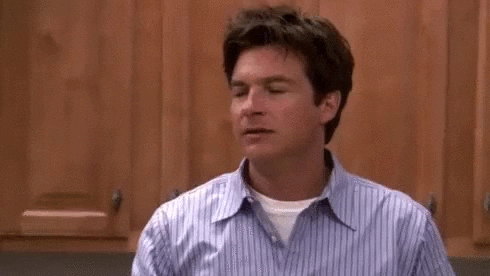
Look for a promotion service that will only pitch to influencers who have playlists that Organically Rank in the Spotify Search Engine for validated keywords - giving you as an independent artist an opportunity to reach real listeners who could turn into organic followers.
Playlists that do not rank in the Spotify Search Engine could have bot activity, low-quality overseas traffic, or other types of risky and unethical practices.
For example, at the Indie Music Academy, we perform 3 analytical checks to “validate” the legitimacy of each playlist:
Let’s use the playlist “Relaxing Music 2020” as our test subject.
2. Signs That a Playlist has an Organic Streams
- No deleted followers on the playlist - Using analytic tools like Chartmetric we check to make sure that there are no sudden dips in the follower growth line indicating a mass deletion of bot accounts.
We look for growth lines that are smooth like this:
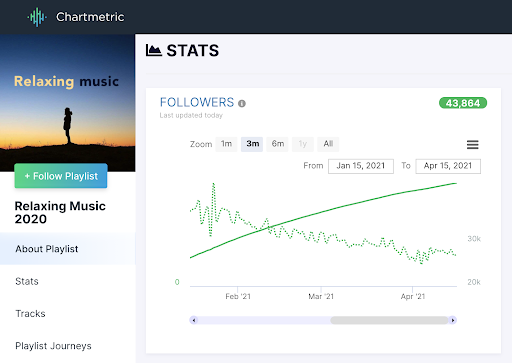
- Playlist Keywords / Playlist Name Have Popularity - We need to validate that the playlist name is popular in the first place. Check for a high search ranking. You can use a tool like Keywords Everywhere to check search engine traffic, like this:

- Spotify Search Rankings - Now we need to check to make sure that our playlist ranks in the Spotify Search results from the search bar. The reason for this is that anyone can create a playlist with a name that has a lot of search popularity. But it’s all for nothing if the playlist doesn’t rank in the top results when searched.
Here’s an example of a playlist that ranks high in the Spotify Search Results:

This is how a lot of artists get taken advantage of. They’ll get placed on playlists that have similar names to the Spotify Editorial Playlists such as “Viral Pop” but they rank nowhere when you search for them. This means that users do not Organically discover the playlist and traffic needs to be generated through low-quality overseas facebook ads or with bots.
For Artists Growing an International Audience - This process works in multiple languages since Spotify is a multi-country app.



We’ve discovered that search results vary on desktop and mobile applications. So if something is not ranking on desktop, check the Spotify Mobile app and vice versa.
Search results will also mix in your own playlists among organically ranking playlists because of a feature called “Contextual Search.” This is normal and does not affect what the rest of the world sees.
3. What is a “Bot” and Why Should I Care About It?
A “bot” refers to automated software which results in computer generated numbers (fake streams) instead of genuine REAL audiences or streams. Bots will not provide you with the realistic fan activity that you and Spotify are both looking for. Platforms like Spotify will penalize you for using bots – and potentially even ban you permanently for usage of such software.
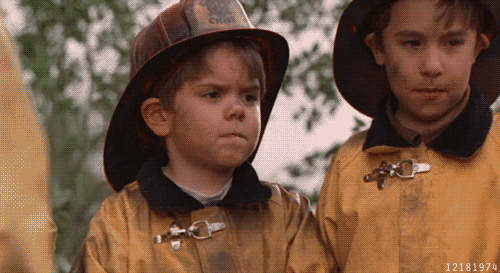
We recommend that you always track progress on your Spotify Artist account to monitor your success—however with more advanced tools you can see a more detailed picture of what’s happening.
For example, some distributors have “device” analytics where you will see that the devices they populate on are mostly “Desktop” and/or “Mobile.” This is a sign of real user activity on Spotify so you can conclude that the streams are real and authentic.
Fake streams on the other hand show an unrealistic amount of plays from the “Other” section of “Devices.” This “Other” area is one that Spotify and other platforms pay direct attention to because of their fictitious nature.
4. Identifying Bot Playlists (Red Flags)
For any playlist campaign it's important to note that the streams should be coming from all over the world as opposed to just 1 region. If streams are only coming from 1 region/country, that typically means the playlist is botted.
One of the biggest red flags when analyzing playlists is a sudden drop in thousands of followers. Spotify regularly deletes accounts that it deems to be “inactive” or “bot” accounts. When there is a noticeable dip in the number of playlist followers, this indicates that the playlist audience was built using sketchy tactics.

Owners of bot-run playlists will gladly scam artists and take their money in exchange for a placement on these unethically built and poor quality playlists.
Here are two things to think about with the Search Engine approach:
- “How are people discovering this playlist?”
- “If it can’t be found by an average Spotify user, where are the streams coming from?”
We want you to know what to look for because every artist deserves a chance to generate real human-driven traffic.
5. What Are Contextual Search (CS) Results and How They Affect Ranking
We’ve discovered that search results vary on desktop and mobile applications. So if something is not ranking on desktop, check the Spotify Mobile app and vice versa.
Search results will also mix in your own playlists among organically ranking playlists because of a feature called “Contextual Search.” This is normal and does not affect what the rest of the world sees. Here's an example:
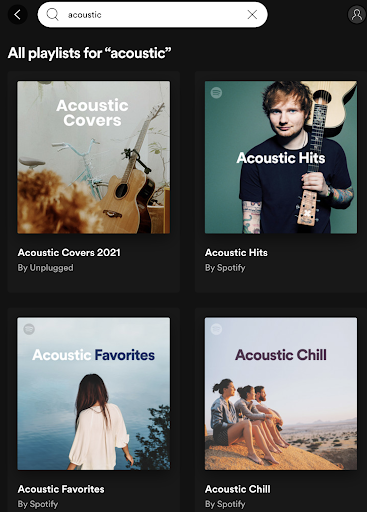
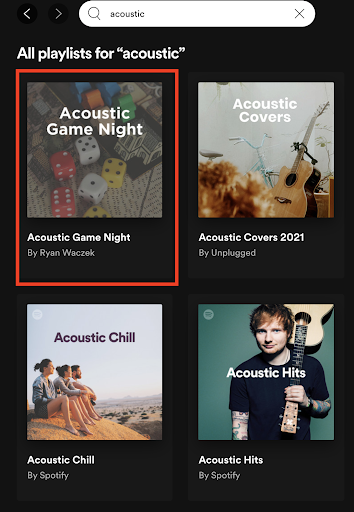
Acoustic Covers 2021 has the top spot in real life but appears second because of CS.
6. Cooperating with Spotify's Terms of Service
The Spotify Terms of Service (TOS) state that no artist can pay for their song to be put on a specific playlist. This is why it’s dangerous to use non-established & sketchy promo service companies who are more than willing to break this iron-clad rule, and risk your music getting taken down off of Spotify.
That’s why it’s our #1 priority to operate 100% within Spotify’s Terms of Service. For two reasons: to protect you as an artist, and secondly so we can uphold our reputation as the best boutique Spotify Playlisting option anywhere in the world.
Here's how we are able to offer Spotify Promotion and still be in line with their TOS:
- We are structured as a Spotify Promotion Agency and when you check out, you are hiring our services, expertise, and friendly team to reach the desired campaign goal. Your money is NOT sent to ANY playlister once you hit the checkout button.
- An organic campaign is simply an influencer marketing campaign which is not against Spotify's Terms of Service because it's a legitimate form of marketing.
On the other hand, paying a playlist curator directly in exchange for a spot is considered “Streaming Manipulation” in Spotify’s TOS. We do not do this and we NEVER recommend paying a playlister directly for a spot on a playlist.
Whew, that's a lot.
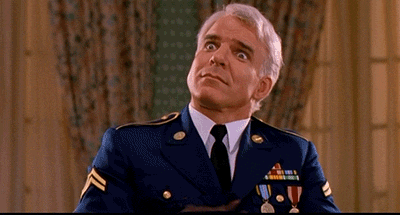
Let's review.
Playlist Legitimacy Checklist:
- No deleted followers or sudden dips in the growth trend line
- Playlist Keywords / Playlist Name Have Popularity in Google
- Playlist ranks at least in the top 10 in Spotify Search Results
- The listeners are from a variety of countries (Spotify is a global app)
- 30 day playlist follower growth ≠ 0 (This means the playlist is inactive)
- In general we avoid playlists that are losing followers
Using Playlists Outside of Genres
It's also good to think outside the box when exploring legitimate playlist options. There are other types of playlists, aside from genre, that can bring surprising results.
Season Based Playlists
Some of our influencers start new playlists with more popular SEO titles, or playlists that match the current season or times we are in.
For example: We've had a lot of success with organic traffic with our "Snowboarding Tunes" playlist. This list does not work when it's not winter because the traffic dies down as no one is looking to snowboard. Say right now we are a month after 4th of July, and we are in the middle of summer, so our "BBQ Vibes" playlist would be performing extremely well with a lot of traffic and searches every single day!
Soundtrack Playlists
Sometimes the best placement for a song is on a “Soundtrack Playlist.” A soundtrack playlist is not the official soundtrack of the movie but rather a fan-generated playlist with songs that are inspired by the movie (it might also include tracks from the Official SoundTrack (OST) within the playlist as well.)
Using soundtrack playlists are a little-known hack that major record labels use with their artists to achieve that “omnipresent effect” (where an artist seems to be everywhere). Spotify users are constantly searching for their favorite movies and shows which creates massive engagement and visibility.
How Do I Use Spotify as a Promotion?
What to Expect with an Organic Spotify Promotion Service
When a company runs organic campaigns for artists, they are bridging the music to curator gap. The company will contact influencers and pitch your song onto their highly active influencer playlists. (Influencers are people who own popular playlists on Spotify, much like a social media influencer with tons of followers.) This gives you thousands of streams. It can also give your brand that artist push it needs to increase your chances of hitting an official playlist placement.
As we mentioned earlier, when starting a promo campaign you might expect from a playilsting company to get you 10-15 placements on playlists with names like “Viral Pop” or “Rap Hits Today” that imitate the names of what you’d think would be a popular playlist by straight up copying the Spotify Curated Playlist names.

But those playlists are highly suspect and might be getting you fake streams. An organic promotion service will take a different approach. Genre is a very non-specific term on Spotify. Remember, playlists are curated EXPERIENCES. And not all experiences are sorted by genre. For example, at the IMA we don't shoot for a variety of placements because it's way too risky.
Organic promotions find placements based more on vibe, sound, & feel so your song will feel right among other songs that all appeal to the same type of listener—this gets you heard by the RIGHT AUDIENCE.
Even once you are on a playlist, since the traffic is 100% organic, it could be weeks to months before the campaign goal is hit. Never fear, sometimes the solution is as easy as adding you to one more playlist.
Every song is different. Some campaigns can last for months to get the streams you requested. Others are over within a few days to a week.
Wait - My Spotify Algorithm, Artist Radio, Algorithmic Playlists went away after purchasing a promotion package?!
Don’t worry, this is completely normal and not permanent at all. In fact it has nothing to do with the quality promotion that you purchased. This is not an indicator of bot activity or a “bad” playlist.

This happens from time to time whenever the Spotify algorithm needs to “recalculate.”
We find this happens most often with artists who are just starting to promote their music for the first time, or when an artist purchases an extremely large package. If there hasn’t been much activity on your Spotify profile and you suddenly go from under 100 monthly listeners to over 5,000+ monthly listeners, then that sudden increase in traffic is enough for Spotify to want to re-analyze the listening habits of your fans.
It simply comes down to the amount of data points that Spotify has regarding your listener base. If all you had in the past were 100 listeners, that small dataset is 100% of how Spotify “knows” you and your sound.
Contrast that to purchasing Spotify Promotion and increasing your data set to over 5,000 listeners, the first 100 listeners is now only 0.2% percent of Spotify’s data set of how people are reacting to your music. 0.2% is nowhere near a complete “understanding” so Spotify will re-analyze your music and listener patterns. This will oftentimes result in your Artist Radio temporarily disappearing while it re-calculates and rebuilds the playlist. Sometimes you will see a decrease in streams from Algorithmic Playlists.
The solution? Well, there really isn’t a solution because this isn’t necessarily a problem.

Your artist radio and algorithm will recalculate and reappear in time if you keep a steady flow of listeners coming to your Spotify Profile.
It’s the big and sudden jump that the Spotify Algorithm can’t “understand” because the new listeners are outlier data compared to your past streaming history. Our best suggestion is to try and be consistent with your promotional habits and to make sure that you are diversifying your promotion tactics within your larger Music Promotion Strategy. Spotify Playlists are just one piece of the bigger picture.
Submitting a Song for a Promotion Campaign Before Release
You might be wondering if you can start the campaign process before your song is released. The answer is yes! At the IMA, we love scheduling promotion campaigns in advance. If your song is not yet released, you can still complete the checkout process by placing a “Preview Link” (SoundCloud, Dropbox, Google Drive, or other) rather than a Spotify link.
Growth in Saves and Followers
Will you get more saves and followers from running a promotion campaign? The short answer is, YES! People who listen to your track will engage if they enjoy it. An organic promotion provides the opportunity for your music to be in front of a much larger, genuine audience than is possible on your own. This will increase your chances of seeing organic growth and building an engaged fan base. Engagement is, as always, based on the caliber of your track.
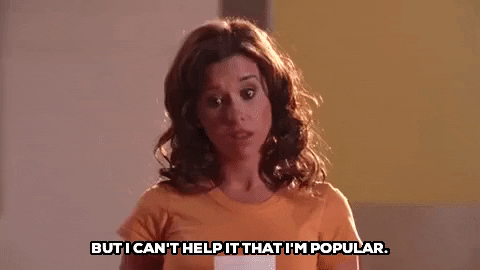
The decision a listener makes to follow or save your song, will always be a subjective choice they make. No matter how you promote, your music following will be built by winning one listener at a time. A playlist push gives your music the influx of new listeners, it’s ultimately up to your song and them to see if a campaign results in followers and/or saves.
Also be sure to keep a balanced perspective. Playlists are helpful towards building a fanbase, but they are not the “end-all-be-all.” Artists should still be working on releasing 1-2 tracks per month, running campaigns as much as possible to wind up on a "New Music Friday" or some other editorial Spotify playlist.
Bonus: Spotify Promotion Case Study
Ryan here - I’m going to show you all the steps, processes, and the exact promotion methods I used to trigger the Spotify Radio Algorithm and get that algorithmic growth, which gives me thousands of extra streams every month, for free from the Spotify App.
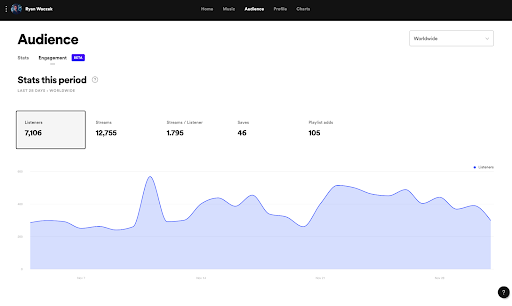
So you will see below more screenshots of my Spotify for Artists analytics showing the aftermath (positive aftermath) of getting on these organic playlists that I offer.
Before we dive in, I want to make sure that you understand everything I’ll be talking about. Check out these videos I made that should bring you up to speed:
Video: How to Understand Your Spotify Analytics
Video: Spotify Playlist Scams and How to Spot Them
Video: Identifying Fake Plays on Spotify
First I want to start by presenting an un-doctored screenshot of my Spotify for Artists portal:

This is the entire history of my music promotion efforts and you can see clearly the spikes in traffic that represent getting on a new playlist.
Getting on a playlist gives a lot of visibility to your music, but as with any “influencer marketing” campaign, the traffic is temporary because you are just “borrowing” the traffic source that is owned by someone else.
Therefore, whenever I get OFF of a playlist, my traffic and “monthly listeners” drops dramatically down to what I call the “new normal.”
Our goal as artists is to use these influencer marketing campaigns (borrowed traffic) to permanently increase our “new normal” to a higher daily listener count (lasting traffic).
Here is a quick overview of my promotion history before I dive into the specifics:
- I tried out a crappy bot-style promotion service from one of my competitors (which was terrible and I definitely would not recommend)
- Then I used Facebook Ads to try and make up for the failed first attempt
- Then I used the same exact 100% Organic Spotify Playlists that I offer on my website and reached a fantastic “new normal”
Let’s zoom into the chart above where I color-coded the different phases of my Spotify Promotion History:

A. My very first song dates back before I began my investigation into the different options for Spotify Playlists—so I started in a very similar place as you might be right now. I ended up choosing a playlist company I regret. I won’t use the real name of the promotion service because I don’t believe in bashing my competitors so for this case study we’ll just call it “BotsMC.”
Using “BotsMC” I got on a ton of early 2000s playlists that seemed very outdated. They seemed to try and overwhelm me by the number of playlists, but they didn’t impress me with the quality of the playlist. In short, it was a lot of garbage and I did not have very many fans sticking around as a result of these first campaigns.
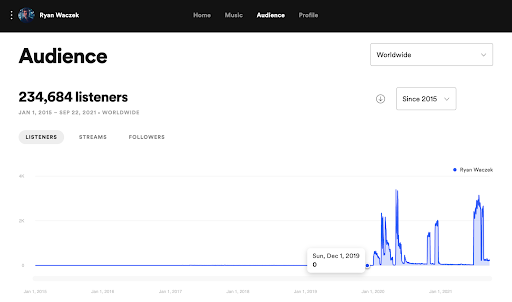
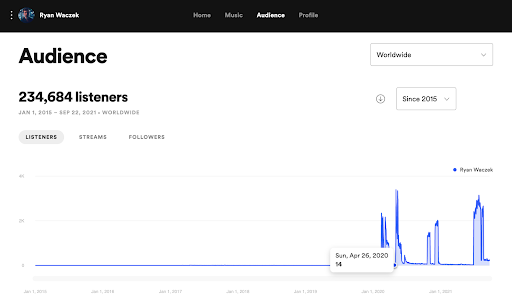
B. After the first promotion fiasco…Second, I used Facebook ads from May 2020 to October 2020 at $10/day. This worked well because I had constant daily listeners that I was paying Facebook to send to my Spotify Profile. Running ads for 6 months at $10/day was very expensive—roughly $1,800!
However, there was one extreme positive to using Facebook ads for that short period of time: my Spotify Followers drastically increased from 316 to 998
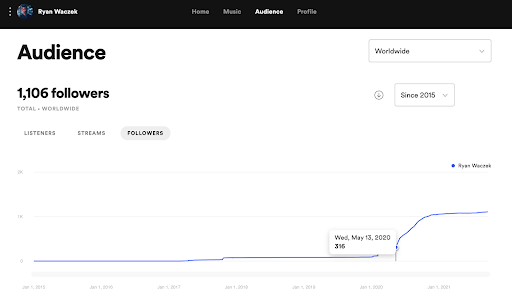
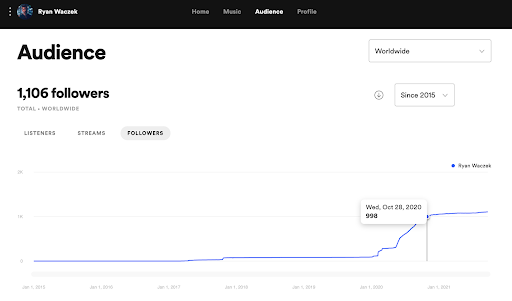
C. Section C is the first time I used my own 100% Organic Spotify Promotion. I partnered with a fantastic company in Los Angeles that helps me manage these promotion campaigns for Indie Music Academy students and the results have been nothing short of fantastic. The reason that these campaigns are so high quality is because I partnered with the same playlist influencers that are used by major record labels like Universal.
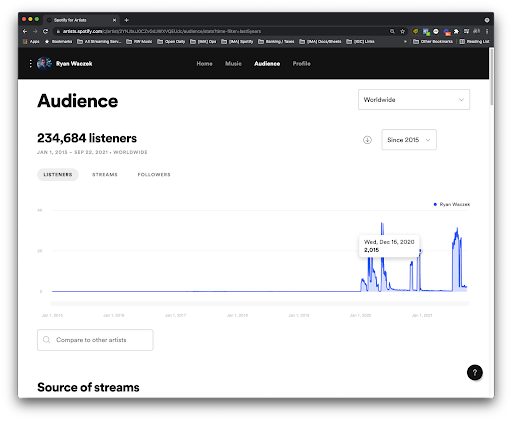
D. All Facebook ads have been turned off and you can see from the image that my “New Normal” after TWO campaigns was equivalent to running Facebook ads spending around $7/day:


Image (Top): Spending $10/day on Facebook ads gave me 72 listeners.
Image (Bottom): After legitimate playlists promotion, I was getting 56 daily listeners with NO ads :)
E. July 2021 through August 2021 I ran THREE more of my 100% Organic Spotify Promotion campaigns and my “new normal” increased drastically—higher than I’ve ever had in my career.
These playlists temporarily increased my traffic to around 2,885 streams per day (see image below):
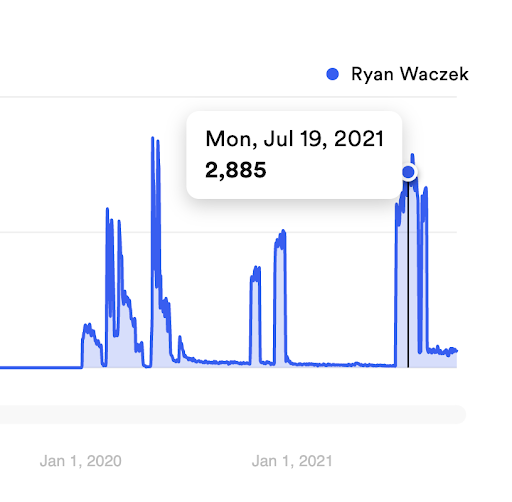
F. My “New Normal” after I got off of these playlists in August 2021 is FAR more than I’ve ever had before (even when compared to when I was running Facebook Ads) to on average 275 streams every single day.
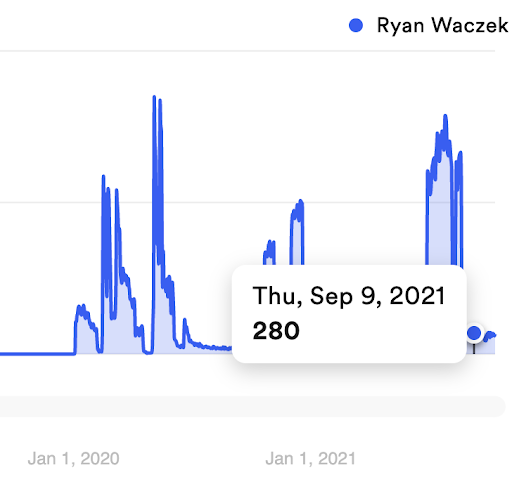
Image: 280 streams per day would be the equivalent of spending $38 dollars every day on Facebook ads. But now Spotify sends them to me for free. This is why it can be more cost effective in the long run to market directly on Spotify rather than trying to convert from an outside platform.
Here is a video to show you that these numbers are not photoshopped or doctored up in any way.
For my songs (which are very well produced pop songs with good lyrics and melody) using my own Spotify Playlist Promotion resulted in a permanent increase in listeners AFTER the campaigns had ended and I was removed from the playlist.
With no current promotions running currently, 49% of my streams are coming from Spotify Algorithmic Sources.
Another 28% are coming from Listener’s own library (which is their own playlists and “Liked Songs”)
And the last 21% is coming from other Playlisters who have decided on their own to add me to their playlists and I’m getting brand new exposure through those traffic sources (without even needing to contact those playlisters)
See images below:
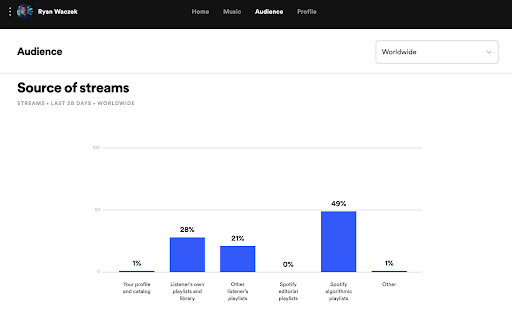


With only 2 songs released (so far) I now have a permanent fanbase of 4.6k monthly listeners as a result of my own Spotify Playlist Promotion service (and a little bit of Facebook Ads).
I highly recommend you give it a shot, or at least shoot me an email with any of your questions about the service.
I only promote things that I 100% believe in and would never recommend a service that is a scam or low-quality.
Hopefully this case study proved that to you today.
UPDATE: Dec. 2021
The Spotify Algorithm isn’t losing steam! Monthly listeners just keep going up without any additional Promotion or Facebook Ads! It feels like I push a snowball down a mountain and now it’s growing and building on its own:
Monthly listeners grew from 4k to 7k
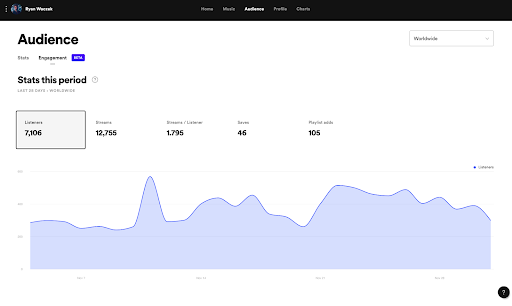
Source of Streams is 74% algorithmic

That was a lot of information, so way to hang in there and read through it. You now have what many artists are missing - a comprehensive understanding of how Spotify Promotion works and what it can do for your music career. Remember, Spotify Playlist Promotions act as one tool in your kit, but with this tool you can level up your Spotify portfolio.
Feeling confident with your new knowledge and ready to start a campaign? Click the link below to check out our Organic Spotify Promotion Services.

Spotify Music Promotion
Most independent artists write incredible songs but they are missing the promotion method that puts their music in front of new fans in a way that matters. Tap into the same network of influencers that major record labels use to spread their reach and find new fans. It's time to build the future of your music career. Click the button to bring thousands of new listeners to your song.





